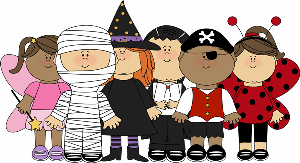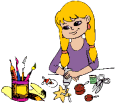All About Halloween for Kids and Teachers
Halloween Facts and Activities
| Halloween | HOMEPAGE | Teacher's Corner |
| Kid's Corner | Holidays & Celebrations | Other Themes |
WE HAVE MOVED TO A NEW URL : http://kiddyhouse.com/celebrations/cs/halloween/"

|
Halloween, Holloween or Haloween?
Halloween is the way to spell it.
Halloween - its Origins and Place in The World Today
It is not hard to imagine anyone reading the title above and immediately thinking of Halloween activities like "trick or treating", pumpkins as lanterns and all sorts of costumes, especially those of the ghostly variety.
But, most of the above are creations during the relatively recent 20th Century, and to find the origins of Halloween we have to go back much further, and particularly across the seas to find the beautiful, green and verdant island, known as Ireland.
The early Irish people were Celtic tribes, similar to those found in Scotland, Wales, Breton (Northern France) and Galicia (an ancient region of N W Spain). The Celts embraced Paganism, one of many hundreds or even thousands of belief systems that were very common in the days before the three Abrahamic religions of Christianity, Judaism and Islam, and are still popular today (eg: Wiccan). The Pagan Celts all spoke Gaelic, although with some differences in each location. No one at that time, however, had yet heard of Halloween.
Paganism comes from the Latin word "paganus" meaning country dweller or rustic. It is a term which, from a Western perspective, has modern connotations of spiritualist, animistic or shamanic practices or beliefs of any folk religion, and of historical and contemporary polytheistic religions in particular.
The Irish Celts had two particularly important Festival celebrations, one which celebrated the arrival of Spring, of renewal, is called Beltane and is on May First with dancing, feasting and the traditional Maypole. The other celebrates the end of the harvest, and arrival of Winter, on the 1st of November and is called Samhain. Incidentally, in the Gaelic language still in use in much of Ireland today, the word for November, is Samhain. Samhain is also generally regarded as the beginning of the Celtic New Year.
By the way, Celtic in all this is pronounced with a hard 'c', as in 'car', whereas in the famous Boston Celtics basketball team, and Glasgow Celtic soccer team it is a soft 'c' the same as in 'Caesar'. Their origins are the same, just different pronunciations.
The ancient Celtic tribes believed that the dividing line between the living and the dead became dangerous for the living on 31st October, when the change in the weather had become much cooler (colder) leading to sicknesses and damage to crops. So, they tried to ward off the perceived evil spirits by lighting bonfires where the bones of slaughtered livestock were thrown. Just like at modern Halloween, at these new festivals, masks and costumes were worn, making them look like evil spirits, in an attempt to placate them and send them far away.
One of the names for these festivals (feast days) was on the eve of Samhain, 31st October, about to be the eve of All Hallows Day, and soon to be known as Halloween.
With the advent of Christianity, in the first Millenium, celebrations had begun of a Festival called All Saint's Day, which was also known as All Hallows or Hallowmass, and was celebrated on 13th May. (Hallow means to make Holy.) The day before All Hallows was called All Hallows Even, and hence shortened to Hallowe'en, and then to the Halloween we have today.
All Saint's Day is a feast held in honour of all saints, known and unknown. In terms of Roman Catholic theology, the feast commemorates all those who have attained the beatific vision in Heaven. (In the RC Church, Sainthood is bestowed on a person who has died, after performing great and wonderful deeds on earth. This process is called beatification.)
The day after All Saint's Day is known as All Soul's Day, and commemorates those who have died, but who have not yet been purified and gone to Heaven. In many parts of the world, especially South America and other largely Catholic countries (such as The Philippines) this day is also known as the "Day of the Dead".
Until the ninth century, when Pope Gregory IV moved All Saint's Day to 1st November, from 13th May, it had really been a festival of Pagan traditions, held just after Beltane on 1st May.
Now that All Saint's Day was on 1st November, it was also on the same day as Samhain. As stated above the day before All Saint's Day (or All Hallows Day), was All Hallows Even, which became shortened to Hallowe'en and thus, Halloween. Gradually, many of the Pagan traditions of Samhain, begun to be incorporated into Halloween, particularly the attempts to ward off the evil spirits, as described earlier, with the costumes and masks.
Of course, the main modern Halloween activities for children today, especially in North America, are 'trick or treating', lantern lighting and dressing in often ghoulish costumes. It appears that this did not really start until the early part of the 20th Century. The first known reference to what is really ritualised begging on Halloween, was reported in 1911, in a Canadian newspaper in Kingston, Ontario, not far from the border with upstate New York. The paper reported that it was normal for the smaller children to go street guising on Halloween between 6 and 7pm, visiting shops and neighbors, to be rewarded with nuts and candies for their rhymes and songs.
Origins of "Trick or Treat"
Guising comes from an old Scottish practice, when children in Scotland and northern England would wear Halloween costumes or disguise, at Halloween, when they went out for their special treats. The major difference to the 'trick or treat' practiced today in America, is that in Scotland (and probably Ireland too), the children are only supposed to receive treats if they perform for the households to which they go. This normally takes the form of singing a song, reciting a poem or even a joke. Occasionally a particularly talented child might do card tricks or play a musical instrument, but most children will receive their treat for doing something quite simple. There was no practice of performing a trick on the householder or neighbour.
Another interpretation of the origins of 'trick or treat', is said to come from the practice of dressing up in costumes and begging door-to-door for treats on holidays. This goes way back to the Middle Ages, and even includes Christmas wassailing - carol singing.
Trick or treating has some resemblance to the old Irish and British practice of 'souling', when poor folk would go door-to-door on Hallowmass (1st November), and be given food in return for prayers for the dead on All Souls Day (2nd November). This practice was even common throughout much of continental Europe, even as far as the south of Italy. It's even mentioned by Shakespeare in his comedy, The Two Gentlemen of Verona.
The halloween trick element of the practice seems to be very modern, and probably in the 1930s in the United States, although exactly where, is unknown for certain. Even how it started is also rather a mystery, although it seems it may have begun when children were refused treats in the years of the Great Depression, and some decided to take their revenge by playing tricks on the householders. These were however, harmless fun tricks like spraying a little water, or going back after the door had been shut, knocking on the door or ringing the bell and running away. Unfortunately in some places these tricks have become nothing short of vandalism, and in the UK these days, the police regularly issue warnings before Halloween that anyone caught vandalising would be dealt with severely, with the full force of the law.
As kids and parents take to the streets for Halloween trick-or-treating, Halloween safety becomes the primary concern. According to the, an estimated 41.1 million children (ages 5-14) hit the streets in 2012 looking to calm their sweet tooth strapped with their best costumes for Halloween.
It's rather sad that in today's world, the fun element of Halloween activities seem to have disappeared in some places. Not only in North America but in most countries, parents nearly always feel compelled to accompany their children, who might otherwise not be safe. Who can blame them, for today we read far too often of crimes where young children are the victim? Whether these crimes actually are more common or whether our media now reports it more, is a moot point, but who would want to take the chance?
So, let's try to make the best of it. Let's have a better understanding of Halloween's origins, Halloween's activities, and let's place greater emphasis on the treat rather than the trick, and above all, let's all have fun!
Contributed by Mike Davies

|
Halloween Printables
Original halloween worksheets from kiddyhouse.com and from others. Halloween coloring activities. |

|
Halloween Crafts
Make some halloween crafts for kids |

|
Halloween Graphics
Find halloween cliparts, halloween animations, halloween backgrounds and more here. |
|
|
Halloween Games
Have fun here playing halloween games and other halloween activities |

|
Halloween Stories
Read fun halloween stories here. |

|
Halloween Songs and Poems
Try singing our "Five Pumpkin Song". Printable available. |

|
Halloween Lesson Plans
Halloween resources for teachers |

|
Halloween Costume Ideas
|
Director: Discovery
Halloween
Where did Halloween Come From?
MORE ABOUT HALLOWEEN
Halloween origins and customs
It talks about the origins of Halloween, the blending of paganism with Christianity and whether
should Christians adopt such practices.
Haloween Facts and misinformation
The history of halloween
Summarized and easy to understand
See what people in England do on Halloween
DISCLAIMER : This is a disclaimer. We try to gather information that are as accurate as possible. However, if there are mistakes, we will not be held liable or responsible for anything. Use it at your own discretion.
We are also not responsible for any links beyond our site.
Many thanks to My Cute Graphics for their wonderful graphics and animations.



